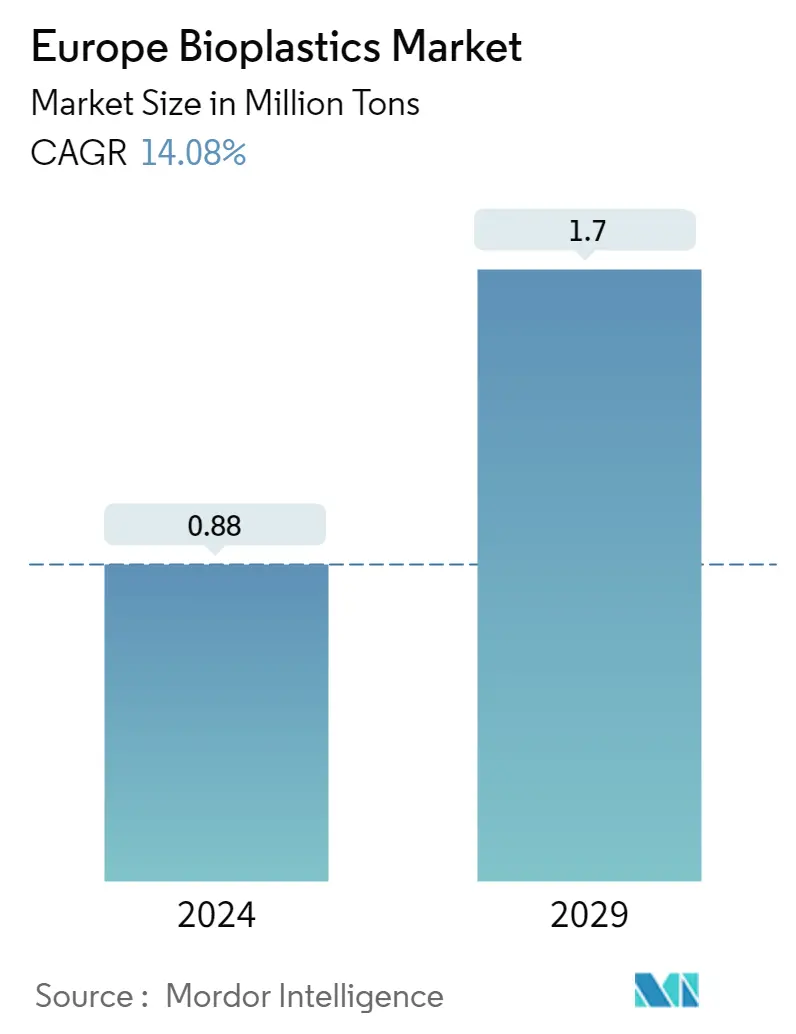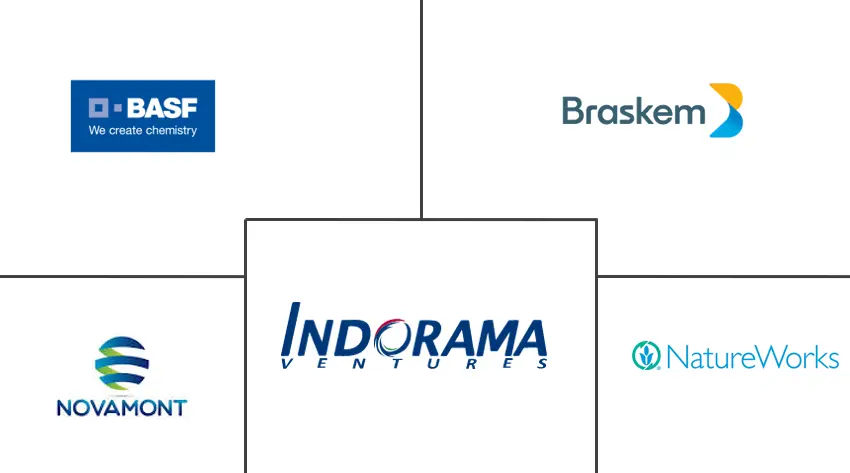Market Size of Europe Bioplastics Industry

| Study Period | 2019 - 2029 |
| Base Year For Estimation | 2023 |
| Market Volume (2024) | 0.88 Million tons |
| Market Volume (2029) | 1.70 Million tons |
| CAGR (2024 - 2029) | 14.08 % |
| Market Concentration | Low |
Major Players
*Disclaimer: Major Players sorted in no particular order |
Europe Bioplastics Market Analysis
The Europe Bioplastics Market size is estimated at 0.88 Million tons in 2024, and is expected to reach 1.7 Million tons by 2029, growing at a CAGR of 14.08% during the forecast period (2024-2029).
Due to the COVID-19 pandemic, the market was significantly impacted in 2020. However, the market is now estimated to reach the pre-pandemic levels.
- Over the short term, major factors driving the market studied are environmental factors encouraging a paradigm shift and growing demand for bioplastics in flexible packaging.
- However, the availability of cheaper alternatives is likely to hinder the market's growth.
- Flexible packaging applications are expected to dominate the market, in terms of volume, during the forecast period.
- Growing use in the electronics industry will likely offer future market opportunities.
Europe Bioplastics Industry Segmentation
Bioplastics are materials derived from renewable biomass sources, such as corn starch, straw, woodchips, vegetable fats and oils, recycled food waste, etc. The market is segmented based on product type, application, and geography. The market is segmented by product type into bio-based biodegradables and non-biodegradables. The market is segmented by application into flexible packaging, rigid packaging, automotive and assembly operations, agriculture and horticulture, construction, textiles, electrical and electronics, and other applications. The report also covers the size and forecasts for the European bioplastics market in 6 countries across major regions. The market sizing and forecasts for each segment are based on volume (kiloton).
| Product Type | |||||||
| |||||||
|
| Application | |
| Flexible Packaging | |
| Rigid Packaging | |
| Automotive and Assembly Operations | |
| Agriculture and Horticulture | |
| Construction | |
| Textiles | |
| Electrical and Electronics | |
| Other Applications |
| Geography | |
| Germany | |
| United Kingdom | |
| Italy | |
| France | |
| Spain | |
| Russia | |
| Nordic Countries | |
| Rest of Europe |
Europe Bioplastics Market Size Summary
The European bioplastics market is poised for significant growth, driven by increasing environmental awareness and the rising demand for sustainable packaging solutions. Bioplastics are gaining traction in flexible packaging applications due to their eco-friendly and degradable properties, making them suitable for packaging films used in food, beverages, and non-food products. The market is experiencing a resurgence post-COVID-19, with flexible packaging expected to dominate in terms of volume. The electronics industry also presents future opportunities for bioplastics adoption. However, the availability of cheaper alternatives poses a challenge to market expansion. The packaging sector remains the largest consumer of bioplastics, with growing concerns over environmental impact fueling demand.
Germany stands out as a key player in the European bioplastics market, with its robust packaging, automotive, and textile industries driving consumption. Government regulations and certifications, such as those by DIN CERTCO, have bolstered the market in Germany. The country's strong manufacturing base, particularly in automotive and textiles, contributes significantly to the demand for bioplastics. The market is characterized by fragmentation, with major players like Braskem, Novamont SpA, NatureWorks LLC, BASF SE, and Indorama Ventures Public Company Limited actively participating. Partnerships, such as the one between Carbios and Indorama Ventures for bio-recycled PET, highlight ongoing efforts to enhance bioplastics production capabilities in the region.
Europe Bioplastics Market Size - Table of Contents
-
1. MARKET DYNAMICS
-
1.1 Drivers
-
1.1.1 Environmental Factors Encouraging a Paradigm Shift
-
1.1.2 Growing Demand for Bioplastics in Flexible Packaging
-
1.1.3 Other Drivers
-
-
1.2 Restraints
-
1.2.1 Availability of Cheaper Alternatives
-
1.2.2 Other Restraints
-
-
1.3 Industry Value Chain Analysis
-
1.4 Porter's Five Forces Analysis
-
1.4.1 Bargaining Power of Suppliers
-
1.4.2 Bargaining Power of Buyers
-
1.4.3 Threat of New Entrants
-
1.4.4 Threat of Substitute Products and Services
-
1.4.5 Degree of Competition
-
-
-
2. MARKET SEGMENTATION (Market Size in Volume)
-
2.1 Product Type
-
2.1.1 Bio-based Biodegradables
-
2.1.1.1 Starch-based
-
2.1.1.2 Polylactic Acid (PLA)
-
2.1.1.3 Polyhydroxyalkanoates (PHA)
-
2.1.1.4 Polyester (PBS, PBAT, and PCL)
-
2.1.1.5 Other Bio-based Biodegradables
-
-
2.1.2 Bio-based Non-biodegradables
-
2.1.2.1 Bio-polyethylene Terephthalate
-
2.1.2.2 Bio-polyethylene
-
2.1.2.3 Bio-polyamides
-
2.1.2.4 Bio-polytrimethylene Terephthalate
-
2.1.2.5 Other Bio-based Non-biodegradables
-
-
-
2.2 Application
-
2.2.1 Flexible Packaging
-
2.2.2 Rigid Packaging
-
2.2.3 Automotive and Assembly Operations
-
2.2.4 Agriculture and Horticulture
-
2.2.5 Construction
-
2.2.6 Textiles
-
2.2.7 Electrical and Electronics
-
2.2.8 Other Applications
-
-
2.3 Geography
-
2.3.1 Germany
-
2.3.2 United Kingdom
-
2.3.3 Italy
-
2.3.4 France
-
2.3.5 Spain
-
2.3.6 Russia
-
2.3.7 Nordic Countries
-
2.3.8 Rest of Europe
-
-
Europe Bioplastics Market Size FAQs
How big is the Europe Bioplastics Market?
The Europe Bioplastics Market size is expected to reach 0.88 million tons in 2024 and grow at a CAGR of 14.08% to reach 1.70 million tons by 2029.
What is the current Europe Bioplastics Market size?
In 2024, the Europe Bioplastics Market size is expected to reach 0.88 million tons.

